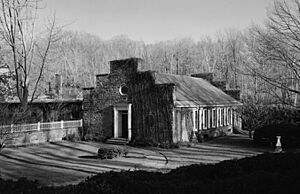History of papermaking in Massachusetts facts for kids
This article explores the exciting history of how paper was made in Massachusetts. For a long time, Massachusetts was a very important place for making paper in the United States.
Contents
Early Paper: From Rags to Riches (1620s-1800s)
In the early days of Massachusetts, paper was made from old cotton and linen rags. This was a common way to make paper in Europe too. As the 1700s went on, more and more books were printed locally. This meant people needed a lot more paper, and old rags became hard to find!
Some paper makers even printed a special message on their paper: "Save Rags!" This shows how serious the shortage was. During the American Revolution, the problem got even worse. Groups called the Committees of Safety in Massachusetts had to make sure every town had someone whose job was to collect rags.
Famous Paper Mills Begin
In 1801, a man named Zenas Crane started making paper in Dalton, Massachusetts. His company later became the famous Crane & Company. This company became very important!
Crane & Company and US Money
In 1857, Crane & Company began making the special paper used for banknotes. By 1862, their paper was officially chosen for all U.S. currency. Even today, Crane & Company still makes the paper for the money we use!
The Smith Paper Company
Another important mill was the "Turkey" mill in Tyringham. Milton Ingersol built it in 1833 to make paper from rags. In 1835, it became Platner and Smith. This company grew very big. By 1850, they bought more mills in Lee, Massachusetts, and on the Laurel Lake outlet. These were called the Castle and Laurel paper mills.
Platner and Smith became the largest paper maker in the whole United States! Later, the company became known as the Smith Paper Company.
Holyoke: A Paper City
In 1849, the Holyoke Dam was finished across the Connecticut River. This led to a huge growth in mills, especially paper mills, all over Massachusetts. For a while, it seemed like paper mills were popping up everywhere! Many small "one-family" mills even started on farms, though not all of them succeeded.
New Ways to Make Paper: Wood Pulp
For a long time, paper was made from rags. But people started looking for new materials.
Early Attempts with Wood
In 1857, Platner and Smith tried making paper from wood pulp. But it was too difficult and expensive back then. The process to turn wood into pulp took a long time, and the paper they made was rough. It didn't print well.
A Breakthrough in Stockbridge
Everything changed in 1866. Albrecht Pagenstecher, a German immigrant living in Stockbridge, Massachusetts, bought two special machines from Germany. On March 5, 1867, in nearby Curtisville, Pagenstecher became the first person in the United States to successfully make wood pulp for paper that could be sold. This was a huge step!
After this discovery, many mills in Holyoke quickly switched to using wood pulp. Soon, Holyoke had twelve major paper mills and became the biggest center for papermaking in the world!
The Paper Industry Changes
Over time, making paper in Massachusetts became more expensive. Labor costs went up, and wood became harder to find locally. Mills in other places, like Wisconsin and Canada, had more forests and cheaper labor.
After World War I, paper mills in Massachusetts began to close down. The industry survived by focusing on making special types of paper, like high-quality writing paper. This continued until the 1970s, when even more changes happened in the paper world.
Images for kids





